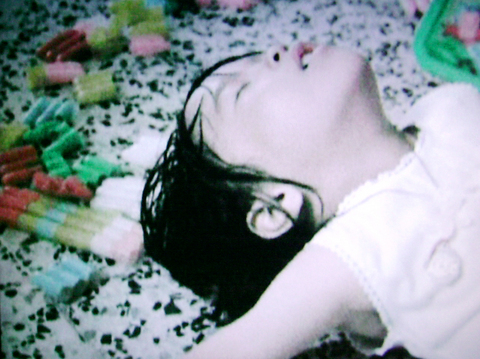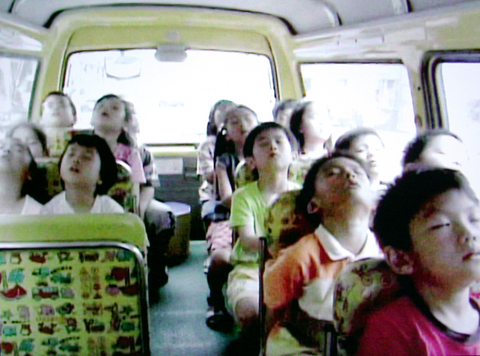I.T Park is known for showcasing avant-garde and experimental artists. For over 12 years its exhibitions have been trendsetting and memorable, while others were risky experiments that did not work out. Currently on view is a solo exhibition that is both commercially viable and experimental at the same time, which in itself is a noteworthy achievement.
Tseng Yu-chin's (曾御欽) first solo exhibition is cryptically titled No One Understands, Even if Crying to Say It or Reliving, Laughing to Say It and features video and projected imagery that channels childhood memories of pleasure, pain and confusion.
Tseng strikes a chord that is simultaneously poetic and discordant within the viewer's heart. He acutely remembers many of those typical childhood feelings but he is nonjudgmental.

PHOTO: SUSAN KENDZULAK, TAIPEI TIMES
Tseng, born in 1978, has accomplished a lot in a short time and does stage design for several performance and theater groups. In addition, he has already published poems and a novel that has won numerous awards.
In spite of using multimedia and film, his works hint at narratives, but it is up to the viewer to fill in the meaning. Upon entering IT Park's darkened space is the psychologically disturbing It's Not So Bad.
Two wall-size simultaneous slide projections continuously flash images of two skinny pre-pubescent boys embracing each other, clad only in their white underpants, hidden in the bushes. The colors are saturated, hinting at forbidden pleasures. The boys' skin glistens with water droplets.

PHOTO: SUSAN KENDZULAK, TAIPEI TIMES
Often adult viewers think Tseng's work is about sexual predation or about pedophilia. However, Tseng's poetic text printed in a pamphlet talks about feelings of self-punishment and captures the angst a young boy feels for the failures and conflicts in his life.
In I Hate Assumption, Tseng has filmed somnam-bulant-like elementary school children. The children are also complicit actors in his films. They go about their normal routines such as riding the school bus, brushing their teeth, preparing for class, all with their eyes closed, their heads thrown back and their mouths agape.
In the elegant but disturbing It Couldn't be Beautiful Video, still images of children passed out on the floor lying amidst overturned boxes of toys and crayons slowly move across the screen. Conjuring up thoughts of poison gas attacks or children frozen in a dream, the work creates conflicting feelings in the viewer such as horror and peaceful innocence at the same time.
In No One Understands an image is shown on one of the four blank screens. An office worker walks out on to the roof with the dense cityscape in the background, emphasizing the existential angst and loneliness of modern life.
Tseng's videos are cinematic in scope providing just enough detail to allow one to surmise a lot about the character: his income, educational level and perhaps his psychological makeup. But Tseng doesn't provide dialogue, plot or a narrative. And so you as the viewer end up filling in all the psychological details, until you realize the artist is telling your story.
Tseng reveals as much as he conceals. He has told you a bit about his truth, so then you start to think about your truth, until suddenly you realized that you revealed more about yourself than he did as his work opened you up.
In other words, his video-works act like ersatz-Rorschach tests in which you see what truths you want to believe in.
Exhibition notes:
What: OXY -- A Solo Exhibition by Tseng Yu-chin
Where: IT Park, 41 I-Tong St, 2/3fl Taipei (台北市伊通街41號2-3摟). Telephone (02) 2507 7243
When: To Nov. 19, Tuesday to Saturday, 1pm to 10pm.

In Taiwan there are two economies: the shiny high tech export economy epitomized by Taiwan Semiconductor Manufacturing Co (TSMC, 台積電) and its outsized effect on global supply chains, and the domestic economy, driven by construction and powered by flows of gravel, sand and government contracts. The latter supports the former: we can have an economy without TSMC, but we can’t have one without construction. The labor shortage has heavily impacted public construction in Taiwan. For example, the first phase of the MRT Wanda Line in Taipei, originally slated for next year, has been pushed back to 2027. The government

July 22 to July 28 The Love River’s (愛河) four-decade run as the host of Kaohsiung’s annual dragon boat races came to an abrupt end in 1971 — the once pristine waterway had become too polluted. The 1970 event was infamous for the putrid stench permeating the air, exacerbated by contestants splashing water and sludge onto the shore and even the onlookers. The relocation of the festivities officially marked the “death” of the river, whose condition had rapidly deteriorated during the previous decade. The myriad factories upstream were only partly to blame; as Kaohsiung’s population boomed in the 1960s, all household

Allegations of corruption against three heavyweight politicians from the three major parties are big in the news now. On Wednesday, prosecutors indicted Hsinchu County Commissioner Yang Wen-ke (楊文科) of the Chinese Nationalist Party (KMT), a judgment is expected this week in the case involving Hsinchu Mayor Ann Kao (高虹安) of the Taiwan People’s Party (TPP) and former deputy premier and Taoyuan Mayor Cheng Wen-tsan (鄭文燦) of the Democratic Progressive Party (DPP) is being held incommunicado in prison. Unlike the other two cases, Cheng’s case has generated considerable speculation, rumors, suspicions and conspiracy theories from both the pan-blue and pan-green camps.

Stepping inside Waley Art (水谷藝術) in Taipei’s historic Wanhua District (萬華區) one leaves the motorcycle growl and air-conditioner purr of the street and enters a very different sonic realm. Speakers hiss, machines whir and objects chime from all five floors of the shophouse-turned- contemporary art gallery (including the basement). “It’s a bit of a metaphor, the stacking of gallery floors is like the layering of sounds,” observes Australian conceptual artist Samuel Beilby, whose audio installation HZ & Machinic Paragenesis occupies the ground floor of the gallery space. He’s not wrong. Put ‘em in a Box (我們把它都裝在一個盒子裡), which runs until Aug. 18, invites